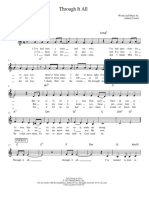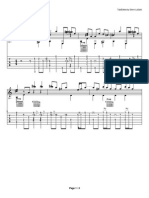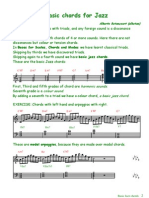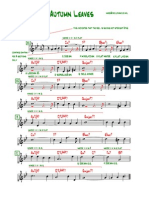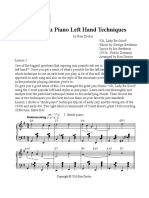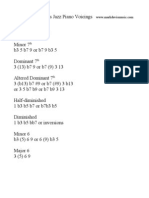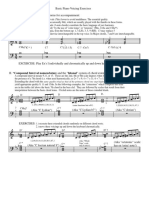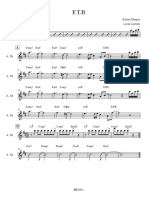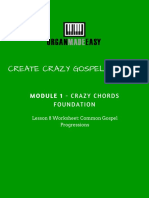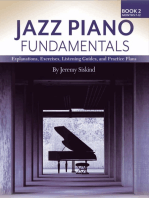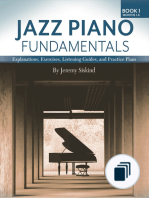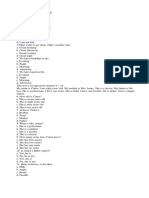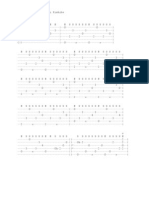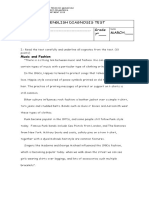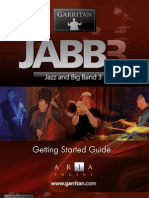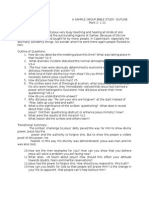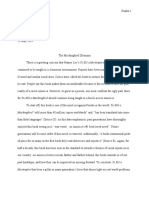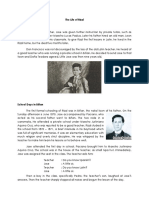Comping 2
Comping 2
Uploaded by
pikbeb65Copyright:
Available Formats
Comping 2
Comping 2
Uploaded by
pikbeb65Copyright
Available Formats
Share this document
Did you find this document useful?
Is this content inappropriate?
Copyright:
Available Formats
Comping 2
Comping 2
Uploaded by
pikbeb65Copyright:
Available Formats
Left Hand Comping
By
Per Danielsson
A general trend among young jazz piano students is the lack of skill regarding left hand comping. Often students are concentrating so much on the right hand improvisation that proper attention
to the left hand is ignored. Needless to say, learning to improvise and use the jazz language is complex and time consuming but its also important to play the piano pianistically, which requires both
hands.
In order to become a complete jazz pianist the practicing should include aspects such as, left
hand comping, articulation, balance between hands, rhythmic perfection, harmonic development etc.
Use the same approach as you would when practicing classical piano. For example, its impossible to
sound good on a Bach piece if you dont bring out the themes and play the piece with technical perfection. A balance between the hands is a must in order to make such piece sound good. If you
never have studied classic you should start today.
Like anything else in Jazz, listen to the masters and learn from them. The next solo you transcribe, transcribe both the improvised lines and the left hand comping. By doing that you will become
more aware of the balance between the two hands.
This article will introduce a couple of concepts that are helpful in order to make better use of
the left hand. It will also give your practicing a direction and eventually the left hand will become an
integrated part of your jazz playing.
1. Static Comping
By doing a repeated rhythm in the left hand you can create an extremely steady and driving
force under you soloing. Its important to keep the rhythm steady and controlled in order to get the
full effect of this style of comping. Below are two different rhythms that works well as static comping.
By alternate the pattern with long or short notes you can create a variety of feels within the same
rhythm.
B b13
Pattern 1.
? c F13
b
J
Pattern 2.
? c F13 B 13 F13 F13
b
J
J
J
J
F 13
F 13
The example on the following page alternate these two rhythms. When you practice, stay on each
rhythm for a while until you get comfortable with them.
j ^ b >
b
c
b
&
#
n b b
>
3
F 13
B b13
F 13
? c
b
J
J
J
- ^
> n b
j n b >
b
b
&
b
B 13
F 13
? B 13
b
J
J
J
j
# # n n b b n
& b #
? G m7
b
J
3
C9
F 13
()
D 7 #9
b b
F 13
J
b ^ - ^
()
J
D7 b9
G m7
C7
2. Accent Comping.
The goal with this way of comping is to strengthen the rhythm in the melody by putting more
force on the accents. It helps to think of it as a big band with the brass section playing hits while the
saxes are playing a soli (check out Thad Jones/Mel Lewis band).
j ^ b >
b
c
b
&
#
?b
&b
?
&b
?
b ^ b
n b b
>
3
b
13
13
F 13
B
F
> F 13
^
^ >
^
c |
.
J
J
J
- ^
- ^
>
^
> >
n b b j n b b
D 7(b 9)
B b13 >
B b13^
F 13
^ G>m7
>
^
|
J J
J
J
J J
# j # # n n b b n
D 7(# 9)
F 13
G m7
C7
3
G m7
C9
^
.
|
|
J
J
J
3. Block Style Comping
This is perhaps more of an effect than actual comping. However, together with the other styles
it is a nice addition and a powerful tool to use. Try to phrase the chords like the melody. Also make
sure that the left hand does not over power the right hand. Practice this way of comping slowly to
make sure you find a good balance between the hands.
j ^ b >
b
c
b
&
#
b ^ b
n b b
>
F 13
>
^
b
? c ^ B 13 >
b
J
- ^
>
> 3
b ^ - ^
j
b
b
&
D 7(b 9)
B b13
F 13
>
>
^
^
^
?
-
b
J
# # n
^
j
n b b n
& b #
C7
F7
D 7(# 9)
G m7 C 7
G m7 3
? b ^
| |
J
3
F 13
4. Pad Comping.
This way of comping creates a smooth and relaxed feel. Its main purpose is to supply a more
constant sound of the harmony by using nice left hand voicings and let them sustain more than the
static way of comping. This works great especially in ballads. All the other techniques that are mentioned in this article can also be mixed into this comping style.
b b
b
&c
C
wwMaj7
b G m7
w
? c ww
&
# E m9
?
A 7(b 9)
# b n
b n # 3
b
3
b C 7(b9)
wwwww F Maj7
b
D m9
b b
b b
b
G 7(b 9)
Maj7 b G #
C
#
b
13
9
( ) # B 7(b9)
F # m7 b 5
C Maj7
You might also like
- Through It AllDocument2 pagesThrough It AllJonathan S. Carlton100% (5)
- Jazz Piano Fundamentals (Books 1 and 2): Explanations, Exercises, Listening Guides, and Practice Plans for the First Year Plus of StudyFrom EverandJazz Piano Fundamentals (Books 1 and 2): Explanations, Exercises, Listening Guides, and Practice Plans for the First Year Plus of StudyNo ratings yet
- Bud Powell Chord Voicings - The Jazz Piano SiteDocument5 pagesBud Powell Chord Voicings - The Jazz Piano SiteMbolafab Rbj100% (1)
- The Outsiders CH 4-6 QuizDocument4 pagesThe Outsiders CH 4-6 QuizMelissa Moreno100% (1)
- Neo-Soul: Example 3 (E7 ( 9) ) Fdim7/eDocument5 pagesNeo-Soul: Example 3 (E7 ( 9) ) Fdim7/eraphaelcorteziNo ratings yet
- English FolkDocument542 pagesEnglish Folkpikbeb65100% (3)
- 2015-08-14 Mantras Rev 1.1Document19 pages2015-08-14 Mantras Rev 1.1NavernM100% (1)
- Basic Jazz Chords PDFDocument7 pagesBasic Jazz Chords PDFEric RamirezNo ratings yet
- Jazz Piano WorkshopDocument7 pagesJazz Piano WorkshopLouise Jones100% (5)
- Scot Ranney's Jazz Piano Notebook, Volume 2, "Latinesque" - Jazz Piano Exercises, Etudes, and Tricks of the Trade You Can Use TodayFrom EverandScot Ranney's Jazz Piano Notebook, Volume 2, "Latinesque" - Jazz Piano Exercises, Etudes, and Tricks of the Trade You Can Use TodayRating: 4 out of 5 stars4/5 (1)
- Three Quick Jazz Practice Tips: for all instruments: Jazz & Improvisation Series, #3From EverandThree Quick Jazz Practice Tips: for all instruments: Jazz & Improvisation Series, #3Rating: 5 out of 5 stars5/5 (1)
- Left HandDocument11 pagesLeft Handlalovelosas100% (1)
- Minor-251 Lesson SupplementDocument5 pagesMinor-251 Lesson SupplementAlex SimonianNo ratings yet
- Lesson Plan - 1. Connecting The Chord Notes - Autumn LeavesDocument5 pagesLesson Plan - 1. Connecting The Chord Notes - Autumn LeavesDavid EgerNo ratings yet
- Learn Jazz Piano, by Scot RanneyDocument4 pagesLearn Jazz Piano, by Scot RanneyslowloveNo ratings yet
- The Voicing Tower: Root 9 Root 9Document2 pagesThe Voicing Tower: Root 9 Root 9Jekaterina SariginaNo ratings yet
- U C M F T N: Niversal Hord Ethod or Onal AvigationDocument6 pagesU C M F T N: Niversal Hord Ethod or Onal AvigationEduardo MontielNo ratings yet
- CompingDocument10 pagesCompingGiancarlo Martino100% (1)
- 2hands Voice LeadingDocument1 page2hands Voice Leadingmachris1964No ratings yet
- Left Hand Rootless Jazz Piano VoicingsDocument2 pagesLeft Hand Rootless Jazz Piano Voicingsmdtree100% (1)
- Dummies Guide To Jazz Standards PDFDocument3 pagesDummies Guide To Jazz Standards PDFratvader68No ratings yet
- Chord Mapping & Common Scales - The Jazz Piano SiteDocument7 pagesChord Mapping & Common Scales - The Jazz Piano SiteMbolafab Rbj100% (1)
- JPS Top 22 Favorite Two-Hand Voicings: & ? WWW# B WWBDocument7 pagesJPS Top 22 Favorite Two-Hand Voicings: & ? WWW# B WWBLaurindo de CastroNo ratings yet
- Keep On (Alfa Mist)Document1 pageKeep On (Alfa Mist)Chiara TucciNo ratings yet
- Paddy Milner Creative Ideas For Your Blues Shuffle 1Document1 pagePaddy Milner Creative Ideas For Your Blues Shuffle 1Javier Montañes100% (1)
- Jazz Piano Skills (Music 15) : TH TH THDocument2 pagesJazz Piano Skills (Music 15) : TH TH THaliscribd4650% (2)
- ClusterDocument2 pagesClusterRodolfo Amaral de AlmeidaNo ratings yet
- Achieving Hand IndependenceDocument9 pagesAchieving Hand IndependenceFrancisco José Hernández Alvear100% (4)
- 6 Sweet Chord Progressions: - in A Kenny Barron StyleDocument4 pages6 Sweet Chord Progressions: - in A Kenny Barron StyleGonzalo Garcia Santos100% (1)
- Chord Construction BasicsDocument1 pageChord Construction BasicsJoe WilliamsonNo ratings yet
- Fourth Voicings For PianoDocument10 pagesFourth Voicings For PianoJac van Egmond100% (6)
- The Basic Progression in Jazz I PDFDocument103 pagesThe Basic Progression in Jazz I PDFStacie Payne100% (1)
- Jazz Chord HanonDocument1 pageJazz Chord Hanonrussspen0% (1)
- Jazz PianoDocument3 pagesJazz Pianovijaymusic880% (2)
- DG 20lickstoexpandyourjazzblues Lick1 TabDocument3 pagesDG 20lickstoexpandyourjazzblues Lick1 TabZardozofozNo ratings yet
- 4 Example 4Document1 page4 Example 4salomeeafNo ratings yet
- Bob Keller - Rootless Voicings For Piano - Jazz PDFDocument36 pagesBob Keller - Rootless Voicings For Piano - Jazz PDFchico_oliveira67% (3)
- Donna Lee Key ChangeDocument2 pagesDonna Lee Key ChangehkrNo ratings yet
- Advanced Locked Hands - The Jazz Piano SiteDocument8 pagesAdvanced Locked Hands - The Jazz Piano SiteMbolafab Rbj100% (2)
- Monk Institute Handout Packet JB Dyas VideoDocument22 pagesMonk Institute Handout Packet JB Dyas VideobaciuffoloNo ratings yet
- II V I Rootless LH Piano Voicings PDFDocument3 pagesII V I Rootless LH Piano Voicings PDFZachary BarnesNo ratings yet
- Comping Voicings (Introduction)Document1 pageComping Voicings (Introduction)PietreSonoreNo ratings yet
- Jazz Keyboard Exercises PDFDocument3 pagesJazz Keyboard Exercises PDF黃紘志67% (3)
- Bill Hilton's Piano Pack 6Document13 pagesBill Hilton's Piano Pack 6maypole501No ratings yet
- Self-Accompaniment and Improvisation in Solo Jazz Piano - Practice3Document18 pagesSelf-Accompaniment and Improvisation in Solo Jazz Piano - Practice3madcedmadced100% (1)
- (Book) Jazz BooksDocument10 pages(Book) Jazz BooksRobertHwang0% (2)
- Oscar Peterson StyleDocument2 pagesOscar Peterson StyleMoises Osorio100% (1)
- Enclosures #1 - Half Step Approach (Major)Document1 pageEnclosures #1 - Half Step Approach (Major)Facundo TorresNo ratings yet
- F.T.B - Alto SaxDocument1 pageF.T.B - Alto SaxLucas LorenziNo ratings yet
- Neo Soul Etude TransposedDocument1 pageNeo Soul Etude TransposedCraig J. Petrocelli IINo ratings yet
- Jazz Piano VoicingsDocument1 pageJazz Piano Voicingshaykminasyan100% (2)
- How To Voice Standards The MenuDocument3 pagesHow To Voice Standards The MenuEnrico Pouls Poletto100% (2)
- Create Crazy Gospel ChordsDocument3 pagesCreate Crazy Gospel ChordsAns SembiringNo ratings yet
- Quartal Jazz Piano Voicings PDFDocument2 pagesQuartal Jazz Piano Voicings PDFMariano Trangol Gallardo0% (1)
- Essential Quartal Triads You Must Know As A Gospel or Jazz Musician - Hear and Play Music Learning CenterDocument28 pagesEssential Quartal Triads You Must Know As A Gospel or Jazz Musician - Hear and Play Music Learning CenterLouis Migliore100% (1)
- Counterpoint in Jazz Piano With Specific Relation To The Solo Work of Fred Hersch - B. HeinenDocument91 pagesCounterpoint in Jazz Piano With Specific Relation To The Solo Work of Fred Hersch - B. HeinenOsvaldo Suarez100% (1)
- Aaron Goldberg 3 QuestionsDocument2 pagesAaron Goldberg 3 QuestionsPno.100% (1)
- Latin Piano Practice Sessions Volume 1 In All 12 Keys: Practice SessionsFrom EverandLatin Piano Practice Sessions Volume 1 In All 12 Keys: Practice SessionsRating: 5 out of 5 stars5/5 (1)
- Jazz Piano Fundamentals (Book 2): Exercises, Explanations, Listening Guides and Practice PlansFrom EverandJazz Piano Fundamentals (Book 2): Exercises, Explanations, Listening Guides and Practice PlansNo ratings yet
- Robin Nolan - The Gypsy Jazz Songbook-6Document20 pagesRobin Nolan - The Gypsy Jazz Songbook-6ccbccb2No ratings yet
- Chords For Drop-D Irish BackupDocument6 pagesChords For Drop-D Irish Backuppikbeb65No ratings yet
- Comping VoicesDocument1 pageComping Voicespikbeb65No ratings yet
- RHYTHMDocument84 pagesRHYTHMpikbeb650% (1)
- Cole Porter For Classical Guitar BookDocument31 pagesCole Porter For Classical Guitar Bookcyrcos100% (7)
- A / The / Zero Article Part II: L Intermediate GrammarDocument25 pagesA / The / Zero Article Part II: L Intermediate GrammarNoemi Gladis Gladis TitoNo ratings yet
- Gabriel Garcia Márquez.1 PDFDocument5 pagesGabriel Garcia Márquez.1 PDFsanazh100% (2)
- Sekolah Menengah Pertama (SMP) Negeri 49: EvaluationDocument4 pagesSekolah Menengah Pertama (SMP) Negeri 49: EvaluationkurniawanNo ratings yet
- Soal Bahasa InggrisDocument15 pagesSoal Bahasa Inggrisfery cagyo wibowo, spNo ratings yet
- Petrarchan SonnetDocument2 pagesPetrarchan SonnetAnn Marey Manio GrijaldoNo ratings yet
- Masaaki Kishibe - ConvertibleDocument5 pagesMasaaki Kishibe - ConvertibleChung Wen WeiNo ratings yet
- Islamic All Books List DownloadableDocument8 pagesIslamic All Books List DownloadableISLAMIC LIBRARY100% (2)
- Hey Little SongbirdDocument2 pagesHey Little Songbirdpippin94No ratings yet
- Worship Hindu GodDocument5 pagesWorship Hindu GodKj NaveenNo ratings yet
- Sample Poem Research PaperDocument7 pagesSample Poem Research PaperNioaka BanuelosNo ratings yet
- Tee 003Document4 pagesTee 003Nasrien KadirNo ratings yet
- Catalogue of CCP Publications 2021Document75 pagesCatalogue of CCP Publications 2021marcheinNo ratings yet
- Lightroom Shortcuts 5 WindowsDocument13 pagesLightroom Shortcuts 5 WindowsDomainNo ratings yet
- Cha Cha 2.0Document12 pagesCha Cha 2.0jezrel gepanaNo ratings yet
- Diagnostico Ingles 7°basicoDocument2 pagesDiagnostico Ingles 7°basicoCarlos OrmeñoNo ratings yet
- IMD 14 - 4thyr Balance: Section ADocument27 pagesIMD 14 - 4thyr Balance: Section AShubham Sheshnath TiwariNo ratings yet
- History of PhilosophyDocument696 pagesHistory of PhilosophyYiru Shi75% (4)
- Mountstuart Elphinstone: Influence of English On Marathi ProseDocument7 pagesMountstuart Elphinstone: Influence of English On Marathi ProseAnil BachateNo ratings yet
- Garritan Jazz & Big Band 3 Getting Started GuideDocument13 pagesGarritan Jazz & Big Band 3 Getting Started GuideGarritanNo ratings yet
- A Sample Bible Study OutlineDocument2 pagesA Sample Bible Study OutlineRuth Caranguian100% (2)
- To Kill A MockingbirdDocument3 pagesTo Kill A Mockingbirdapi-462975983No ratings yet
- Estimating GuideDocument42 pagesEstimating Guidegerome aribanNo ratings yet
- Language and Literature DP 2 - 2019-2020Document29 pagesLanguage and Literature DP 2 - 2019-2020Shuaib MohamedNo ratings yet
- WQ in White DwarfDocument5 pagesWQ in White DwarfasiriNo ratings yet
- CCB Nivel SII 2007.1Document5 pagesCCB Nivel SII 2007.1Diogo HenriqueNo ratings yet
- Ma Sarada and RadhuDocument4 pagesMa Sarada and RadhuFace Less100% (1)
- Rizal's EducationDocument8 pagesRizal's EducationJoyce Ann Cortez100% (1)
